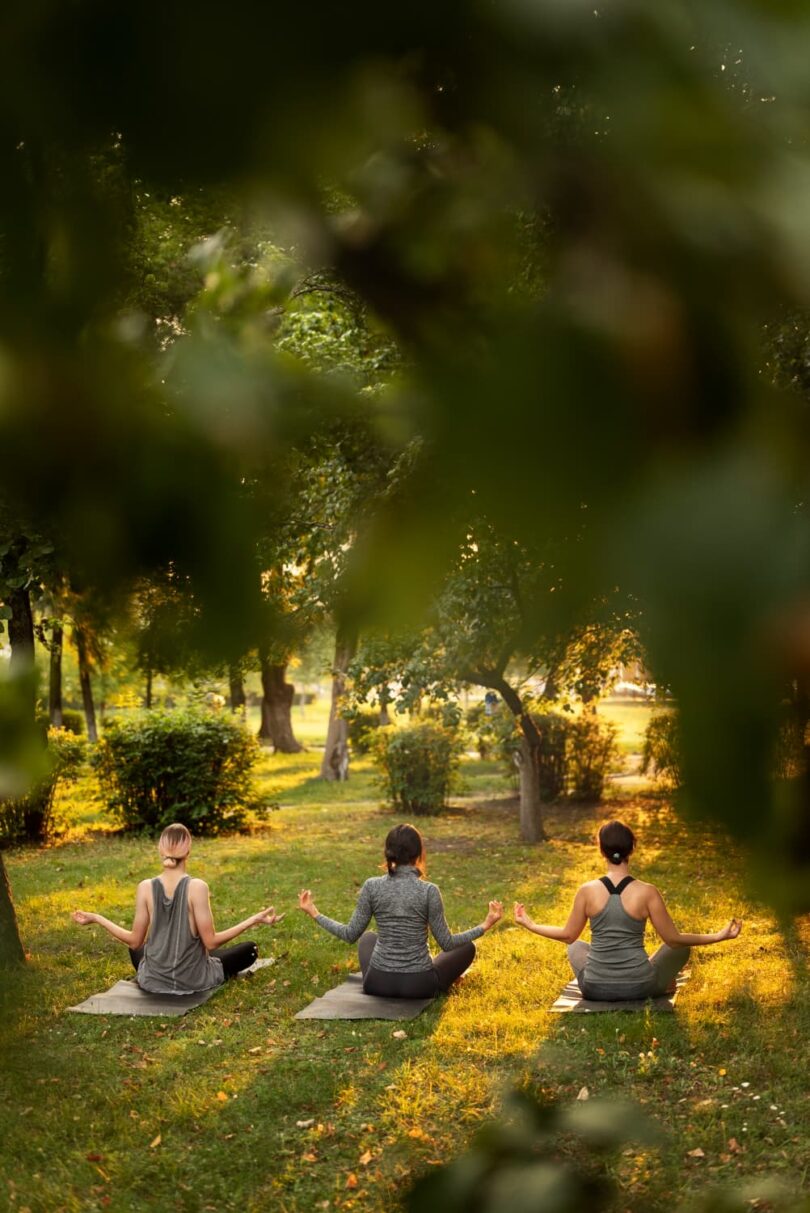Yoga is a powerful practice that offers a wide range of benefits for both the body and mind. Originating in ancient India, yoga has grown to become a popular form of exercise and relaxation around the world. This article will guide you through the history, benefits, and various practices of yoga while also providing tips on how to integrate yoga into your daily life. Let’s dive into the wonderful world of yoga!
Table of Contents
What is Yoga?
Definition
Yoga is a practice that combines physical postures, breathing exercises, and meditation to achieve harmony between the mind and body. Originating in ancient India, the word “yoga” means to yoke or unite, symbolizing the integration of physical and spiritual aspects of an individual.
Origins and History
The origins of yoga can be traced back to over 5,000 years ago in Northern India. It was first mentioned in ancient sacred texts called the Rig Veda. Over centuries, yoga evolved and was refined by various sages and philosophers. Patanjali, an ancient sage, compiled the practices into what is now known as the Yoga Sutras, a foundational text for many yoga practices today.
Types of Yoga
There are several types of yoga, each with its unique focus and benefits. Some of the most popular forms include Hatha Yoga, which emphasizes physical postures and breath control; Vinyasa Yoga, known for its fluid movements; and Ashtanga Yoga, a more rigorous style with a fixed sequence of poses.
The Philosophy Behind Yoga
Ancient Roots
Yoga’s philosophy is deeply rooted in ancient Indian traditions. It encompasses various principles such as ethics, discipline, and spiritual practices aimed at achieving a balanced and fulfilling life. The eight limbs of yoga, as outlined by Patanjali, provide a framework for personal development and spiritual growth.
Spiritual and Mental Aspects
While yoga is often associated with physical postures, its mental and spiritual aspects are equally important. Through practices like meditation and breath control, yoga helps calm the mind, reduce stress, and promote mental clarity. These practices encourage self-awareness and mindfulness, allowing individuals to connect with their inner selves.
Next up, we’ll delve into the physical benefits of yoga, highlighting how it can improve flexibility, strength, balance, and overall physical health. Stay tuned for part two, where we explore the transformative impact yoga can have on your body!
Physical Benefits of Yoga
Improving Flexibility and Strength
Yoga is well-known for its ability to improve flexibility and build strength. Regular practice involves stretching various muscle groups, which helps to increase the range of motion and prevent injuries. For instance, poses like Downward Dog and Warrior can significantly improve flexibility in the hamstrings, calves, and shoulders. Additionally, holding these poses builds muscle strength, particularly in the arms, legs, and core.
Enhancing Balance and Coordination
Balance and coordination are crucial aspects of overall physical fitness, and yoga excels in these areas. Many yoga poses, such as Tree Pose and Eagle Pose, challenge your balance and require you to focus on stability. Practicing these poses regularly can enhance your proprioception, which is your body’s ability to sense its position in space. Improved balance reduces the risk of falls and enhances coordination, which is beneficial for daily activities and other forms of exercise.
Boosting Physical Health
Yoga offers a multitude of physical health benefits beyond flexibility and balance. Here are some key areas where yoga can positively impact your health:
- Cardiovascular Benefits: Yoga can improve cardiovascular health by reducing stress, lowering blood pressure, and enhancing circulation. Poses that involve dynamic movements, like Sun Salutations, can also provide a mild cardiovascular workout.
- Respiratory Health: Breath control, or pranayama, is a fundamental aspect of yoga that can enhance respiratory efficiency. Techniques such as Ujjayi and Kapalabhati breathing improve lung capacity and oxygenation.
- Immune System Support: Regular yoga practice can boost your immune system by reducing stress hormones, enhancing lymphatic flow, and promoting relaxation. This combination helps the body fight off infections more effectively.
The physical benefits of yoga are vast and varied, making it a valuable addition to any fitness routine. In the next part, we’ll look at the mental and emotional benefits of yoga, focusing on how it can reduce stress, improve mental clarity, and support emotional well-being. Stay with us for more insights into the holistic advantages of this ancient practice!
Mental and Emotional Benefits of Yoga
Stress Reduction
One of the most praised benefits of yoga is its ability to reduce stress. Through a combination of physical postures, breathing exercises, and meditation, yoga helps calm the mind and relax the body. Practices like Shavasana (Corpse Pose) and Pranayama (breath control) are particularly effective for stress relief. These techniques slow down the heart rate and promote a state of deep relaxation, allowing the body to release tension and anxiety.
Improving Mental Clarity and Focus
Yoga also plays a significant role in improving mental clarity and focus. The practice encourages mindfulness, which is the act of being present and fully engaged in the current moment. This mindfulness is cultivated through focused breathing and intentional movement, helping to quiet the mental chatter and improve concentration. Techniques such as Trataka (focused gazing) and Dhyana (meditation) are excellent for sharpening the mind and enhancing cognitive functions.
Emotional Well-being
Yoga contributes greatly to emotional well-being. Regular practice can help balance emotions and improve overall mood. The physical activity involved in yoga releases endorphins, which are the body’s natural mood lifters. Moreover, the meditative aspects of yoga encourage self-reflection and self-acceptance, fostering a more positive outlook on life. Poses like Heart-Opening Backbends and Hip-Openers are known to release emotional blockages, leading to a greater sense of emotional freedom and stability.
By integrating yoga into your routine, you can enjoy these mental and emotional benefits, making you feel more balanced and at peace. Up next, we’ll discuss the different popular yoga practices, providing an overview of their unique benefits and what you can expect from each. Keep reading to find out more about how to tailor your yoga journey to suit your individual needs!
Popular Yoga Practices
Hatha Yoga
Hatha Yoga is one of the most common and accessible styles of yoga. It focuses on physical postures and breath control, making it ideal for beginners. Hatha Yoga sessions typically include a series of poses, or asanas, that are held for several breaths. This practice helps improve flexibility, build strength, and promote relaxation. If you’re new to yoga, Hatha Yoga is a great starting point for building a strong foundation.
Vinyasa Yoga
Vinyasa Yoga, often referred to as “flow” yoga, is characterized by its dynamic and fluid movements. In Vinyasa classes, poses are linked together in a sequence, synchronized with the breath. This continuous flow creates a dance-like rhythm that keeps the practice engaging and invigorating. Vinyasa Yoga is excellent for improving cardiovascular fitness and building stamina. Poses like Sun Salutations are a staple in Vinyasa classes, offering a full-body workout.
Ashtanga Yoga
Ashtanga Yoga is a more rigorous and structured style featuring a set sequence of poses performed in a specific order. Each session begins with sun salutations, followed by a series of standing and seated poses, and ends with a closing sequence. Ashtanga Yoga is physically demanding and promotes discipline and dedication. It’s an ideal choice for those seeking a challenging practice that builds both physical and mental strength.
Bikram Yoga
Bikram Yoga, also known as hot yoga, is practiced in a heated room with temperatures around 105°F (40°C). This style consists of a fixed sequence of 26 poses and two breathing exercises. The heat helps to loosen muscles, allowing for deeper stretches and detoxification through sweat. Bikram Yoga can be intense, but it offers numerous benefits, including improved flexibility, circulation, and endurance. Just be sure to stay hydrated and listen to your body.
Each of these yoga practices offers unique benefits and caters to different preferences and fitness levels. By understanding the characteristics of each style, you can choose the one that best suits your goals and interests. In the next part, we will discuss how to integrate yoga into your daily life, making it a consistent and rewarding part of your routine. Stay tuned for practical tips on starting and maintaining a yoga practice!
Related Article: Yoga Stretches: Powerful Poses for Flexibility and Relaxation
Integrating Yoga into Daily Life
Starting a Yoga Practice
Starting a yoga practice can be simple and rewarding. First, find a class or online tutorial that suits your level and interests. Many beginners prefer to start with Hatha Yoga because of its gentle and slower-paced nature. If you’re short on time, there are numerous short yoga routines available online, like the 20-minute home workout by Yoga With Adriene.
Setting up a comfortable space at home can also make it easier to stick with your practice. Choose a quiet area where you won’t be interrupted, and keep your yoga mat and any props handy. Consistency is key, so try to practice at the same time each day, even if it’s just for a few minutes.
Creating a Balanced Routine
Incorporating yoga into your daily routine doesn’t mean you have to practice for hours each day. A balanced routine can include a mix of yoga, other forms of exercise, and rest days. For instance, you might do a 30-minute Vinyasa flow three times a week, combined with cardio or strength training on other days.
To maintain variety and prevent burnout, mix up your yoga sessions with different styles and focuses. One day, you could work on flexibility with Hatha Yoga, while another day, you might challenge yourself with an Ashtanga sequence. This approach keeps your practice interesting and engaging.
Tips for Consistency
Staying motivated can be challenging, but here are some tips to help you stick with your yoga practice:
- Set Realistic Goals: Start with achievable goals, such as practicing for 10 minutes a day, and gradually increase the duration as you become more comfortable.
- Track Your Progress: Keep a yoga journal or use an app to track your sessions and note any improvements in flexibility, strength, or mood.
- Join a Community: Practicing with others, whether in a class or an online community, can provide support and motivation. Sharing your experiences and progress can make yoga more enjoyable.
- Listen to Your Body: Pay attention to how your body feels and adjust your practice accordingly. It’s important to rest and recover when needed to avoid injury.
By integrating yoga into your daily life, you can enjoy its many benefits without feeling overwhelmed. In the next section, we’ll delve into advanced yoga practices, including poses for experienced yogis, yoga for athletes, and how to become a yoga instructor. Stay tuned for more insights on deepening your yoga journey!
Advanced Yoga Practices
Deepening Your Practice
For those who have been practicing yoga for a while and are looking to deepen their practice, there are several advanced poses and techniques to explore. Advanced yoga poses, such as Handstands (Adho Mukha Vrksasana), Forearm Stands (Pincha Mayurasana), and Advanced Backbends (Kapotasana), require strength, balance, and flexibility. These poses can take time to master, so patience and consistent practice are essential.
In addition to physical poses, deepening your practice also involves extending meditation sessions and incorporating more advanced breathing techniques like Nadi Shodhana (alternate nostril breathing) and Bhastrika (bellows breath). These practices can enhance mental clarity and emotional stability.
Yoga for Athletes
Athletes can benefit greatly from incorporating yoga into their training routines. Yoga helps improve flexibility, reduce the risk of injuries, and enhance mental focus. Specific yoga routines can be tailored to complement various sports. For instance, runners can benefit from poses that stretch the hamstrings, calves, and hip flexors, such as Pigeon Pose (Eka Pada Rajakapotasana) and Downward Dog (Adho Mukha Svanasana).
Yoga also aids in recovery, helping athletes relax and rejuvenate their muscles after intense training sessions. Incorporating restorative yoga practices and stretches can accelerate the healing process and improve overall performance.
Yoga Teacher Training
For those passionate about yoga and interested in teaching, yoga teacher training (YTT) is a rewarding path. YTT programs provide in-depth knowledge of yoga philosophy, anatomy, teaching techniques, and hands-on practice. These programs typically require a significant time commitment, often involving 200 or 500 hours of training.
Becoming a certified yoga instructor allows you to share your passion with others and guide them on their yoga journeys. It also deepens your own practice and understanding of yoga, making it a transformative experience both personally and professionally.
FAQs and Common Concerns
What are the best yoga poses for beginners?
Beginners should start with simple poses to build a solid foundation. Mountain Pose (Tadasana), Downward Dog (Adho Mukha Svanasana), Warrior I (Virabhadrasana I), Cat-Cow (Marjaryasana-Bitilasana), and Child’s Pose (Balasana) are great starting points. These poses help improve flexibility, strength, and balance while also teaching the fundamentals of alignment and breath control.
How often should I practice yoga?
Consistency is key, but the frequency of your practice depends on your goals and schedule. For general health and well-being, practicing yoga three to four times a week can be very effective. If you’re looking to gain flexibility or reduce stress, even a daily practice of 20-30 minutes can make a significant difference.
Can yoga help with back pain?
Yes, yoga can be very effective for alleviating back pain. Poses such as Cat-Cow, Child’s Pose, and Downward Dog help stretch and strengthen the back muscles, providing relief from tension and discomfort. However, it’s important to practice under the guidance of a qualified instructor, especially if you have chronic or severe back pain, to avoid further injury.
What should I wear to a yoga class?
Comfortable, stretchy clothing that allows for a full range of motion is best for yoga. Avoid clothes that are too loose, as they can get in the way during poses. Many people prefer wearing leggings or shorts and a fitted top. It’s also common to practice yoga barefoot to maintain a good grip on the mat.
Is yoga suitable for all ages and fitness levels?
Absolutely! Yoga can be adapted to suit people of all ages and fitness levels. There are gentle styles like Hatha Yoga and Restorative Yoga that are ideal for beginners, seniors, and those with limited mobility. Conversely, more vigorous styles like Vinyasa and Ashtanga can challenge those looking for a more intense workout.
Conclusion
Yoga is a versatile practice that offers a wealth of benefits for the body, mind, and spirit. Whether you’re seeking to improve physical health, reduce stress, or find a sense of inner peace, yoga provides tools that can help you achieve these goals.
Starting with the basics, you can gradually build a practice that fits your lifestyle and personal needs. As you progress, you may find joy in exploring different styles, deepening your practice with advanced poses, or even sharing your passion by becoming a yoga instructor.
Remember, the journey of yoga is personal and unique to each individual. Consistency and patience are key, and there’s no right or wrong way to practice. The important thing is to listen to your body, stay committed, and enjoy the process.
Incorporate yoga into your daily routine, and you’ll likely find that its benefits extend far beyond the mat. From improved physical health to greater mental clarity and emotional well-being, yoga can truly transform your life in meaningful ways.
So, roll out your mat, take a deep breath, and embark on this wonderful journey. Namaste.
Related Article: Yoga Inspo: Find Inspiration for Your Yoga Practice







